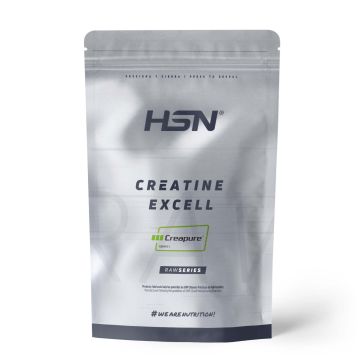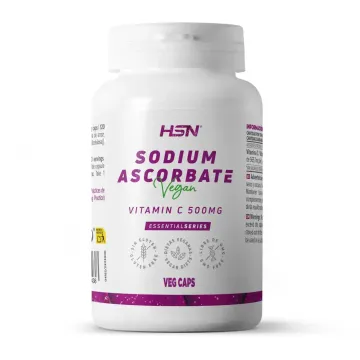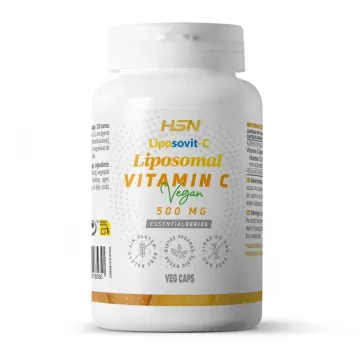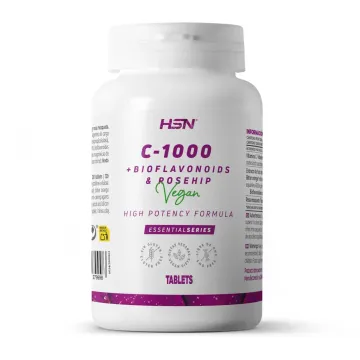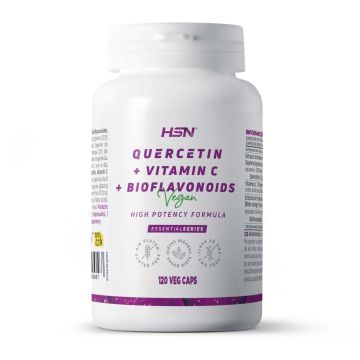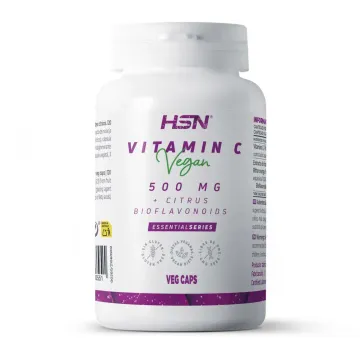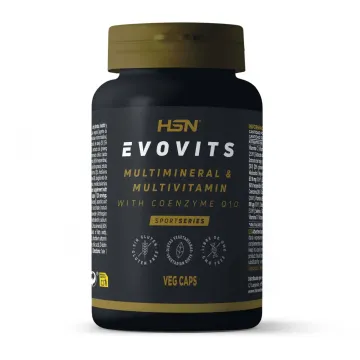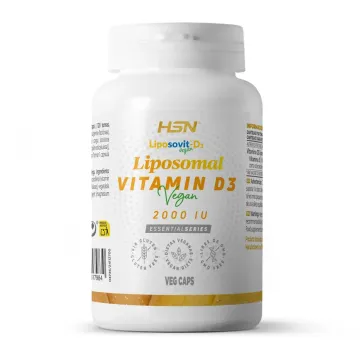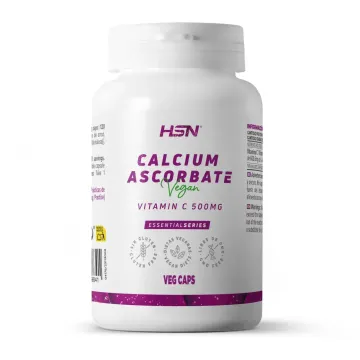- Calcium salt of ascorbate - Stable and highly bioavailable form of vitamin C.
- Highly effective Vitamin C - pH around 7 - Buffered formulation.
- Enjoy the benefits of vitamin C without using ascorbic acid (acidic substance).
- Presentation with high base content of vitamin C: 82% elemental content.
- High stability and resistance to environmental aggressions - Much less oxidizable than traditional vitamin C.
- In vegetable capsules suitable for vegan diets - No allergens - No additives added for aesthetic reasons.
Calcium Ascorbate - An effective presentation of Vitamin C
Calcium Ascorbate (500mg Vitamin C) from EssentialSeries is a dietary supplement in vegetable capsules, developed from the calcium salt of ascorbic acid, combining calcium ion with vitamin C in an approximate ratio of 18:82.
Calcium L-ascorbate is the calcium salt of L-ascorbic acid. Calcium L-ascorbate has the molecular formula C12H14CaO12, the molecular weight of the compound is 390.31 g. And its pH in a 10% solution is around 7 points, unlike ascorbic acid which is around 2.5, which is one of the main reasons why many people prefer the use of calcium ascorbate salt over pure vitamin C.
HSN's calcium ascorbate is a simple and effective formula, with a high concentration of the calcium salt of vitamin C to complement your daily needs of this essential vitamin.
Discover HSN's quality controls. We tell you
Calcium Ascorbate, how is it developed?
Vitamin C salts (ascorbate) follow a relatively complex preparation system but with shared characteristics; all start from the same molecule: Ascorbic acid.
Ascorbic acid is pure vitamin C as such:
The molecular formula of Ascorbic Acid is C6H8O6 and the molecular weight is 176.12 g/mol. The Chemical Abstracts Service (CAS) registry number is 50-81-7.
This compound is combined with a calcium salt, often calcium carbonate, in a solution that is processed to raise the pH of vitamin C (buffering it) and form calcium L-ascorbate (ionic form of L-ascorbic acid), with a variable calcium content around 10%, in this case for our raw material, 18%; the remaining content: Pure vitamin C.
500mg of Vitamin C vs 500mg of calcium ascorbate
One of the major issues related to ascorbate salts is that many dietary supplement companies do not know or do not recognize that a percentage of the compound is not vitamin C, but the associated ion that forms the salt. And this is always the case: Always.
Many companies sell 500mg of calcium ascorbate as pure vitamin C (500mg) but this is not the case, and it may be indicated out of ignorance by the company, or as a form of deception, since given that the vitamin C content is about 80% of the salt, you would be consuming about 20% less vitamin C than you think, about 400mg approximately.
What do we do at HSN?
We give you all the information so you can make a truly informed purchase, and through this content, we explain what you need to know so you can choose:
Our calcium ascorbate provides 500mg of vitamin C per capsule, but not 500mg of calcium ascorbate, because that way it would be impossible for its vitamin C content to be 500mg. Each capsule providing 500mg of vitamin C contains 608.6mg of the calcium salt of L-ascorbate.
Transparency, safety, and effectiveness: HSN!
At HSN we work only with the best raw materials, 100% pure.
Our manufacturing process is completely internalized with total custody of the development flow, ensuring total quality control on our part. Additionally, our manufacturing is certified by the highest recognition accreditations in the food quality industry.
We do not develop formulas that are not effective, all our products have immense research work backing them, no compound has been randomly selected or without studying its behavior, safety, and effectiveness; nor has any dose been added without considering what is the guaranteed safety range in convergence with maximum effectiveness.
At HSN you will find quality products, like our calcium ascorbate that provides 500mg of pure vitamin C per capsule.
High stability. Preferred option less prone to degradation
Normally when looking to supplement the diet with vitamin C, ascorbic acid is simply chosen, but it has problems, such as being very delicate to environmental aggressions, mainly to exposure to oxygen and UV radiation from sunlight.
Calcium ascorbate is a much more stable vitamin C salt than ascorbic acid, it is more resistant and tolerant to this type of exposure and it is easier that with careless preservation it remains functionally in optimum state.
People who transport vitamin C, for use at work during lunch, or around workouts along with the protein shake, are more likely to acquire sodium ascorbate or calcium ascorbate over ascorbic acid as it is more resistant to exposure to oxidizing agents if it is not going to be consumed at the moment it is taken out of the package.
Calcium ascorbate is the favorite form of vitamin C for people on the go.
High dosage: 500mg of Vitamin C per capsule
Vitamin C has a very wide dosage range that goes from a few milligrams to a gram or more.
Sedentary and inactive people need a minimum daily intake of vitamin C, from all sources, very low, only 80mg; however, athletes may need higher minimum amounts, such as 280mg, to keep their immune system functioning properly.
The supplementation dose is variable, but around 500mg is the general consumption recommendation, as it is a safe amount for all users while being effective.
Enjoy a high dosage of 500mg of vitamin C per unit, for complete and guaranteed effectiveness.
At HSN we minimize the use of additives. Check it out!
Additives are agents that are added to products to improve technological aspects of them, for example, their preservation or appearance, and although they have been rejected by a significant sector of consumers, used in reasonable amounts they are completely safe.
However, at HSN we prefer not to add additives whenever they are not necessary nor help the purpose of the product, which is why our capsules are transparent like us, they have no colorants or opacifying agents; because they are not necessary and there is no need for you to have them in your diet unnecessarily.
Also, not all compounds need the same additives, for example, many compounds are highly hygroscopic and require anti-caking agents to improve their preservation, but this does not occur with calcium ascorbate, and that is why our dietary supplement is 'clean label' free of additives beyond the vegetable coating agent that forms the capsule.
What vitamin C suits me best? HSN Options
You have different formulas with ascorbic acid as the main source of vitamin C, as well as the same sodium salt of ascorbate, as this calcium presentation.
Find them all in the 'Vitamin C' category at HSN.
Normally ascorbic acid is the preferred source for supplementing the diet with vitamin C, as it is 100% pure vitamin C, effective and with excellent absorption.
However, the solution it forms is acidic, and its stability is delicate so if you are a person who:
- Is going to transport vitamin C capsules outside the home.
- Does not have too much control over the conservation conditions of the products.
- Follows alkaline diets, or avoids consuming acidic foods due to their impact on the enamel.
The ascorbate salts: calcium and sodium, available at HSN are your best options.
Bibliographic References
- Carr, A. C., & Maggini, S. (2017). Vitamin C and immune function. Nutrients, 9(11).
- Pullar, J. M., Carr, A. C., & Vissers, M. C. M. (2017). The roles of vitamin C in skin health. Nutrients, 9(8).
- Wilkinson, M., Hart, A., Milan, S. J., & Sugumar, K. (2014). Vitamins C and E for asthma and exercise-induced bronchoconstriction. Cochrane Database of Systematic Reviews, 2014(6), CD010749.
- Schleicher, R. L., Carroll, M. D., Ford, E. S., & Lacher, D. A. (2009). Serum vitamin C and the prevalence of vitamin C deficiency in the United States: 2003-2004 National Health and Nutrition Examination Survey (NHANES). American Journal of Clinical Nutrition, 90(5), 1252–1263.
- Hemilä, H., & Chalker, E. (2013). Vitamin C for preventing and treating the common cold. Cochrane Database of Systematic Reviews, 2013(1).
 Before
Before After
After During
During Morning
Morning Afternoon
Afternoon Night
Night








